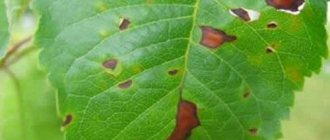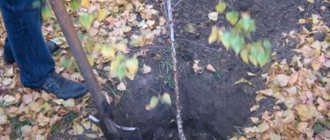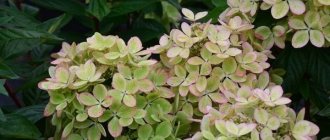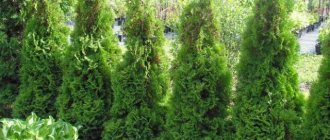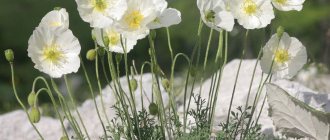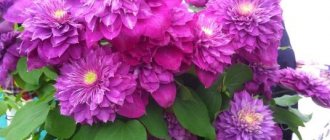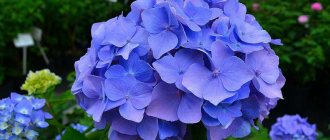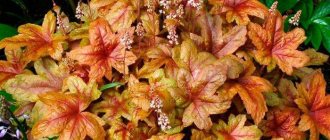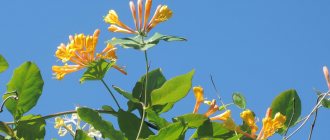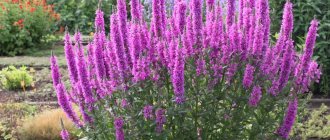Description of the species
The branched crown of the polar birch reaches up to 1.5 m in width. It is characterized by small round leaves that smoothly shift from bright green at the top to soft green at the bottom of the plant. The leaves are attached to the stems by short petioles.
Descriptions of different varieties of dwarf birch differ from each other, but it is very difficult to find a tree taller than 1 meter. These birches are so low-growing that sometimes they are seen only up close - they are small caps of foliage sticking out slightly from the soil. Birch trees grow slowly, reproduce with small, round, slightly elongated earrings. After ripening, they scatter into their component parts - seeds and scales.
Nana begins to flower before releasing its leaves. Modest flowers disappear very quickly, after which small fruits appear that look like nuts up to 2 mm in size. Low-growing birches, creeping along the earth's surface, beautifully bending and intertwining, grow in the northern territories: Canada, Alaska and Russia. The root system of dwarf birches is designed in such a way that the tree independently finds a place for itself among mountain rocks and swamps. The low-growing shrub has become widespread in the field of landscape design due to its compact and rounded foliage that does not require special care.
Curious notes about birch
Since ancient times, birch branches have been used to decorate Orthodox homes and churches on Trinity Sunday. Leaves with alum are used to give the wool a yellow color. Birch is known in beekeeping as an excellent pollen supplier. A birch sliver has long been used by peasants for lighting, since it practically did not produce soot when burning, and shone very brightly.
How to care for blackberries
Firewood made from birch wood is of good quality, and this material is also used for crafts, making plywood and skis, and weapon stocks. If you use birch bark and dry distill it, you get birch tar, which is used for medicinal purposes.
Birch is a supplier of sap, which is full of useful substances and sugar. Not only do people drink it, but when evaporated, it is also offered to bees for spring preparation.
For a long time, healers knew about the medicinal properties of birch, and used the buds and leaves for tinctures because of their diuretic and bactericidal properties, and these drugs can also help heal wounds and reduce fever. An extract obtained from birch buds was prescribed for dermatological problems. Well, brooms made from birch branches with leaves were always taken to the bathhouse in Russia.
Varieties of dwarf birch
The tree is small in size, but it is not as simple as it seems at first glance. There are two groups of plants of this species:
- Nana, characterized by non-sticky shoots with fluff. The leaves are almost round, 2-2.5 cm in diameter. This variety has spread to the northwestern territories of Asian countries, alpine peaks and Greenland.
- Exilis has hairless shoots; they are sticky due to the secretion they secrete. The leaves are small - no more than 1.2 cm in length and a little more in width. Dwarf birches of this group grow in the Asian part of Russia, Canada and Alaska.
Most of the decorative birch varieties belong to the exilis subspecies. Dwarf birch trees of the Golden variety grow very slowly, in 10 years they grow no more than 30 cm in height and 70 in width. A mature tree grows up to 70 cm in height and up to 1.5 meters in width. It looks very impressive, so these varieties make bright accents when decorating the landscape:
- Dwarf birch variety Golden Treasure is a small and compact shrub with yellow lacy leaves. Highly valued by landscape designers for its decorative shape and brightness. It looks like a highly branched, spreading bush with slightly raised shoots. The variety is very rare, growing up to 10 cm every year. Flowering in May before leaves bloom. Grows well in sun to partial shade; soil type is not important, but moderate moisture is desirable.
- The Golden Dream variety is a decorative deciduous shrub with a round, branched shape. Grows up to 1.2 m in height and up to 1.5 m in width. The apex of the leaves is slightly rounded, the base is wide-wedged, up to 2.5 cm in diameter. In summer, the leaves are green, bordered with black in the center and turning yellow towards the end. Flowering is the same as Treasure's, unpretentious to soil, loves sun and moisture. Reproduction occurs by transplanting cuttings and seeds.
What kind of plant is dwarf birch?
Externally, the tree bears almost no resemblance to its slender and tall relative. Residents of the North call this birch “ernik”, which means “bush”. The favorite places for this plant to grow are mountain slopes, swampy areas of the Tundra and other northern regions of the globe.
In cold climates, plant branches are able to grow above the surface of the ground, where, with the onset of a long winter, they can remain for a long time under a thick layer of snow, which protects them from freezing. As a result, the birch does not look like an ordinary tree, but a shrub that spreads along the ground , has gray-brown bark and flexible shoots that grow rather slowly. The tree often grows into thickets of lichen, only green leaves and catkins remain visible on the surface. Thus, the plant can spread over considerable distances and occupy quite large areas on the ground.
The leaves of the miniature tree are oval-shaped, light green with jagged edges, about 2 cm long. With the onset of autumn, they change their color to orange and bright red and look very picturesque. The tree blooms from May to June with small earrings of a green-yellow hue. After pollination, the catkins dry out and fruits appear on the branches - small nuts, brown in color, several millimeters in size.
In northern latitudes, such birches prefer the vegetative method of propagation, because the seeds cannot always fully ripen due to the onset of cold weather. Since all parts of the plant literally spread along the ground, appear on them , and then young shoots are formed in these places, from which new branches are subsequently formed. This shrub grows slowly and has very high frost resistance.
Dwarf birch serves as food for domestic animals and is also successfully used as fuel. Local residents use the leaves and buds of the plant to prepare medicinal decoctions that can treat diseases such as rheumatism, gout, arthritis, and remove stones from the bladder.
This unusual tree looks very decorative and requires minimal care, so it is very suitable for landscaping parks, garden plots, greenhouses, and areas near municipal buildings. In addition, the crown always looks very compact, neat and does not require constant trimming.
Spreading
Dwarf birches are widespread in the tundra, on mountain tops above 500 m, in sphagnum swamps in the taiga zone. Outwardly, they are in no way similar to classic tall birches with a thin spotted trunk and large leaves. Only a knowledgeable person will independently determine that a small shrub spread above the ground is one of the types of birch trees. In their habitat, shrubs form dense thickets.
In the Nenets dialect, dwarf birch trees are called dwarf birches (shrubs), it is impossible to get through them - many crooked branches are tightly intertwined with each other.
Dwarf birch grows in harsh conditions and is therefore fully adapted to them. In the Arctic zone it grows in the tundra, and in other regions on mountain slopes and peaks.
Planting and care
Before planting dwarf ornamental birches, gardeners take into account some nuances:
- It is better to plant trees in the fall.
- Dwarf plants are unpretentious to soil, but it is better to mix garden soil with sand, humus and crushed stone. Additionally, loam is used.
- The rhizome is placed in a small hole and carefully straightened out.
- The top needs to be well sprinkled with soil.
- Afterwards, water without overdoing.
You also need to care wisely:
- It is better to grow the plant in the light, in partial shade.
- In dry times, it is better to spray and water periodically, especially after planting.
- Fertilize twice a year: nitrogen-containing in the summer and complex in the winter.
- The soil cannot be loosened.
- It is useful to mulch the soil near the trunk of the bush, this way you can avoid overheating and moisture evaporation.
- Since the bush grows in harsh conditions, it is also accustomed to frost.
- The shrub needs to be pruned only in the 2nd year after planting in early spring.
- The dwarf tree needs regular treatment against parasites and fungi.
Growing
Before you plant this unpretentious and pretty tree on your site, you should not forget that this plant feels great in the cold season and tolerates any frost well. Therefore, it will not be very comfortable for him to exist in a warm, heated room or on a sunlit piece of land.
If you want the plant to be as comfortable as possible in the area where you decide to plant it, it is recommended to comply with the following conditions:
- The soil . In nature, the shrub usually grows in marshy lands. To plant on your site, you need to select moist and loose soil with minimal acidity. After planting, the plant should be watered abundantly and as often as possible.
- Lighting . The small size of trees that grow in the cold conditions of the Tundra is caused by a lack of sunlight and the presence of frozen soil. But you should not forget that the plant needs sunlight for full growth and development, since the plant is a light-loving plant.
- Temperature . A low-growing tree will not be frightened by low air temperatures, but in very hot weather conditions in the summer it is necessary to protect the birch from direct rays of the sun.
- Humidity . It is best to plant the plant in a place where groundwater flows close to the soil surface. If this is not possible, then the soil in which the dwarf birch will grow will need to be regularly and quite abundantly watered, and the bush will need to be sprayed frequently.
Reproduction
Propagated by seeds or cuttings. The seeds are collected after they ripen in earrings, and then immediately sown. You can also sow in late autumn, covering everything with peat or sawdust. This is a very labor-intensive process that not every gardener will do, so it is best to plant cuttings or seedlings of dwarf birch trees. They are available in large quantities in nurseries; it is not recommended to buy them from hand.
Also, do not buy seedlings that have an open root system - they may simply not take root. It is better to buy a plant immediately in a container with soil or a lump of soil. Seedlings are planted in late autumn or spring:
- The hole for planting is prepared 14 days in advance by pouring garden soil, humus, peat and sand onto the bottom in a ratio of 2:1:1:1.
- Afterwards, complex fertilizer is applied - about 200 grams per hole.
- After planting, the area near the trunk is mulched with a large layer of humus, sawdust or any other covering material.
- Watering is required.
Planting a birch tree on the site
All types of birch are completely unpretentious. For growing, choose a sunny position or light partial shade. Soil requirements are low. The culture grows well in any type of soil, both in poor sandy and fertile substrates, but does not tolerate stagnant water. The only species that can tolerate excess water and grows well in swamps is black birch.
Birch trees can be planted in containers from spring to autumn, and bare-rooted seedlings are planted when they are dormant in November and early March.
When planting a birch tree on a site, you should take into account the size of the tree. Large specimens are planted at a distance of 4-5 meters from each other and from buildings. The distance between dwarf varieties is one and a half to two meters.
Read also: A story about a cherry, grade 3, the world around us
Low-growing varieties are an ideal solution for small areas, rock gardens and look great in composition with conifers, ornamental trees and shrubs (purple, barberry, willow, spruce, thuja, larch, spirea, chokeberry, etc.).
The rules for planting birch trees are simple. Dig the hole in a sunny location protected from strong winds. Mix the soil from it with part peat, two parts compost or leaf soil. If the soil is heavy, add half of coarse river sand for water permeability.
The plant is placed in a hole, the roots and root collar are covered with soil. The soil is compacted and watered well. Since the root system of the tree is superficial, all planted seedlings must be strengthened by tying them to a support.
Meaning and Application
The tundra has favorable conditions for the growth of dwarf trees. That is why such bushes are the most common tundra plants. There are entire impenetrable thickets of intertwined shoots of bushes, this is especially typical for the southern part of the tundra.
Neighbors in the growing region are mosses, lichens, and miniature willows, which are considered the only food for local inhabitants. The local population uses shoots of large bushes as fuel.
Due to their excellent decorative properties, dwarf birch trees have found their use in the design of garden complexes in landscape design. Garden birch will look good in autumn (autumn gardens); it is planted in rockeries, rock gardens and group plantings. The plants look good with low evergreen coniferous trees, as well as with other similar species.
Pests
Insect pests, such as mole crickets, aphids, thrips, beetles, leaf sawflies, and borers, also attack dwarf birch trees growing in the garden. To protect the plant, it is sprayed with chemicals or folk remedies - infusions of tobacco dust, garlic, and hot pepper.
The birch genus (Betula) includes about 40 species of trees and shrubs found in the temperate and cool Northern Hemisphere. Thanks to its decorative qualities, the picturesque tree with an airy crown has found wide application in garden landscape design.
Varieties and types of birch are fully adapted to the climate of the middle zone. The culture is characterized by rapid growth and unpretentiousness. Low decorative birch trees are beautifully presented as tapeworms against the background of a lawn, as well as in groups, in the company of, for example, conifers.
Depending on the species, the bark can be white, dark, yellow or even slightly pink. The root system is usually small and highly branched, so there is not sufficient stability in strong winds.
Caring for birch is not difficult, and planting in containers can be done throughout the season.
Use in landscape design
Dwarf birch is used for decorative purposes. Suitable for creating small hedges, landscaping large spaces, in areas with exotic elements or Japanese motifs. They also combine shrubs with small artificial ponds along with creeping willow. Garden birches will be a good choice for beautifying gazebos and the area around the house. By planting a bush in a pot, you get an excellent ornamental plant for the home, like a bonsai.
Ornamental shrubs will be an excellent addition to mixborders and rock gardens, as well as gentians and saxifrages.
Under natural conditions, the plant is food for animals and fuel for people, and shrubs are also considered a medicine. Dwarf decorative birch trees are an excellent addition to the landscape, bright and attracting attention. When combined with the same small cranberry bushes, ferns, and moss meadows, we get worthy examples of tundra nature.
